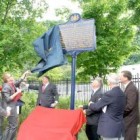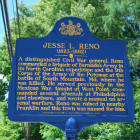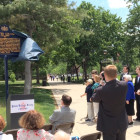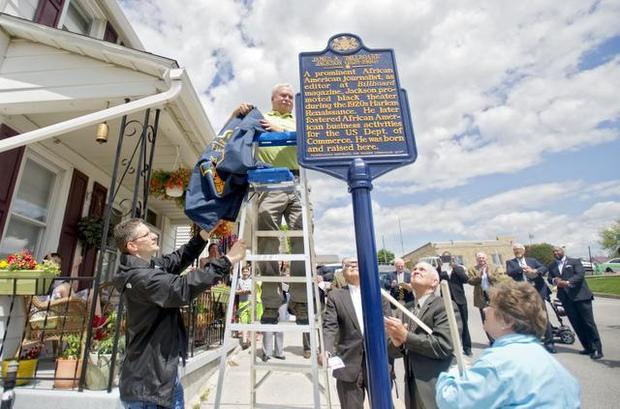The Historical Marker Program is one of the Pennsylvania Historical and Museum Commission’s (PHMC) most popular public programs. Since 1913, well over 2000 markers have been erected throughout the Commonwealth.
 Initially, PHMC’s predecessor, the Pennsylvania Historical Commission (PHC) erected bronze plaques on boulders or stone monuments. When the State Archives, State Museum and the PHC combined in 1945 to form the PHMC, the modern Marker Program was born. Blue and gold painted aluminum markers on posts replaced the bronze plaques.
Initially, PHMC’s predecessor, the Pennsylvania Historical Commission (PHC) erected bronze plaques on boulders or stone monuments. When the State Archives, State Museum and the PHC combined in 1945 to form the PHMC, the modern Marker Program was born. Blue and gold painted aluminum markers on posts replaced the bronze plaques.
In the early years of the program, the nomination process was exclusively staff driven. Local organizations often collaborated on dedication ceremonies, but the marker subjects were chosen and researched by PHMC staff. There was a transitional period in which some markers were proposed by staff and others were nominated by members of the public. Over the last few decades, the nomination process has become exclusively public driven. Staff has provided assistance with preparation of many nominations, but the interested member(s) of the public is responsible for the completion of the nomination form and doing the research to document the subject’s significance.
 The Commission has established Approval Criteria for evaluating marker nominations. The criteria have been slightly revised since first adopted in the 1980s, but the primary criterion, “that the subject have statewide and/or national rather than local or regional historical significance” remains in effect. A requirement for inclusion of scholarly documentation with each nomination was recently added to ensure accuracy of the markers. Although thought to have been implied previously, the criteria currently includes the requirement that the subject, if an individual, have a substantial connection to Pennsylvania, more than simply having been born here. The person must have spent enough time in Pennsylvania to have been shaped here or have exhibited a long-term effect of having lived here.
The Commission has established Approval Criteria for evaluating marker nominations. The criteria have been slightly revised since first adopted in the 1980s, but the primary criterion, “that the subject have statewide and/or national rather than local or regional historical significance” remains in effect. A requirement for inclusion of scholarly documentation with each nomination was recently added to ensure accuracy of the markers. Although thought to have been implied previously, the criteria currently includes the requirement that the subject, if an individual, have a substantial connection to Pennsylvania, more than simply having been born here. The person must have spent enough time in Pennsylvania to have been shaped here or have exhibited a long-term effect of having lived here.
 A Guideline sheet is provided with each nomination form and it includes questions to consider when proposing a subject for a marker. There are also tips about what the panel is and is not looking for, e.g. “a nomination that suggests a subject solely due to sensationalism, durability or longevity, or philanthropy or beneficence does not conform with the intention of the State Historical Marker Program.” In most years, nominations for the oldest of a type of site or organization are submitted and they are often unsuccessful. If the subject was the oldest and first of a type, it would have a better chance of success, because being the first suggests a level of innovation not necessarily there with something that is the oldest. If the oldest site or organization ceased to exist the marker may become invalid, but if it was the first of a type, it will always be the first.
A Guideline sheet is provided with each nomination form and it includes questions to consider when proposing a subject for a marker. There are also tips about what the panel is and is not looking for, e.g. “a nomination that suggests a subject solely due to sensationalism, durability or longevity, or philanthropy or beneficence does not conform with the intention of the State Historical Marker Program.” In most years, nominations for the oldest of a type of site or organization are submitted and they are often unsuccessful. If the subject was the oldest and first of a type, it would have a better chance of success, because being the first suggests a level of innovation not necessarily there with something that is the oldest. If the oldest site or organization ceased to exist the marker may become invalid, but if it was the first of a type, it will always be the first.
 The most common reason that a subject is not approved is that it does not have statewide and/or national historical significance. This criterion has a bit of subjectivity, but it is expected a nominated individual’s actions, achievements, or contributions had broad impact on a statewide or national level. For example, a person who served as a state senator or even a US senator would not automatically qualify for a PHMC marker. The person would have had to have been the sole or primary author/sponsor of legislation that had broad and lasting impact, or possibly to have been involved in a national political campaign. If they brought national attention to an important issue in the Commonwealth of Pennsylvania, it may warrant a marker. Nominations for churches are quite common, but only those that were the first of a denomination, or that were the site of an important event, or that prompted changes within the larger church that were pioneered there would be approved for a marker.
The most common reason that a subject is not approved is that it does not have statewide and/or national historical significance. This criterion has a bit of subjectivity, but it is expected a nominated individual’s actions, achievements, or contributions had broad impact on a statewide or national level. For example, a person who served as a state senator or even a US senator would not automatically qualify for a PHMC marker. The person would have had to have been the sole or primary author/sponsor of legislation that had broad and lasting impact, or possibly to have been involved in a national political campaign. If they brought national attention to an important issue in the Commonwealth of Pennsylvania, it may warrant a marker. Nominations for churches are quite common, but only those that were the first of a denomination, or that were the site of an important event, or that prompted changes within the larger church that were pioneered there would be approved for a marker.
 It is generally helpful for a potential nominator to consult with PHMC staff in the initial stages of their research. Staff is available to review draft nominations, and can provide advice on whether or not a particular subject is viable and suggest ways to adjust focus or sources to pursue that would afford one a better chance for approval. PHMC is especially interested in encouraging markers for underrepresented subjects or in underrepresented regions in PA. If interested in learning about how to apply for a PHMC marker, search for an existing marker, or simply to learn more about the Marker Program, please visit our website.
It is generally helpful for a potential nominator to consult with PHMC staff in the initial stages of their research. Staff is available to review draft nominations, and can provide advice on whether or not a particular subject is viable and suggest ways to adjust focus or sources to pursue that would afford one a better chance for approval. PHMC is especially interested in encouraging markers for underrepresented subjects or in underrepresented regions in PA. If interested in learning about how to apply for a PHMC marker, search for an existing marker, or simply to learn more about the Marker Program, please visit our website.

The Historical Marker Program link does not work!
Thanks for the heads-up. I have corrected the link.
You all should erect the John Hayden marker which did not happen due to funding. It was initially approved in 2010. James Edmundson
Actually, that marker was approved in 2008. There was no follow-through from the nominator on funding commitment or dedication planning. The PHMC currently requires that nominators and/or sponsoring organizations fully cover the costs of manufacture and installation. Also, if there is no action on approved markers within 3 years of approval, the nomination must be resubmit and again go through the nomination and approval process.